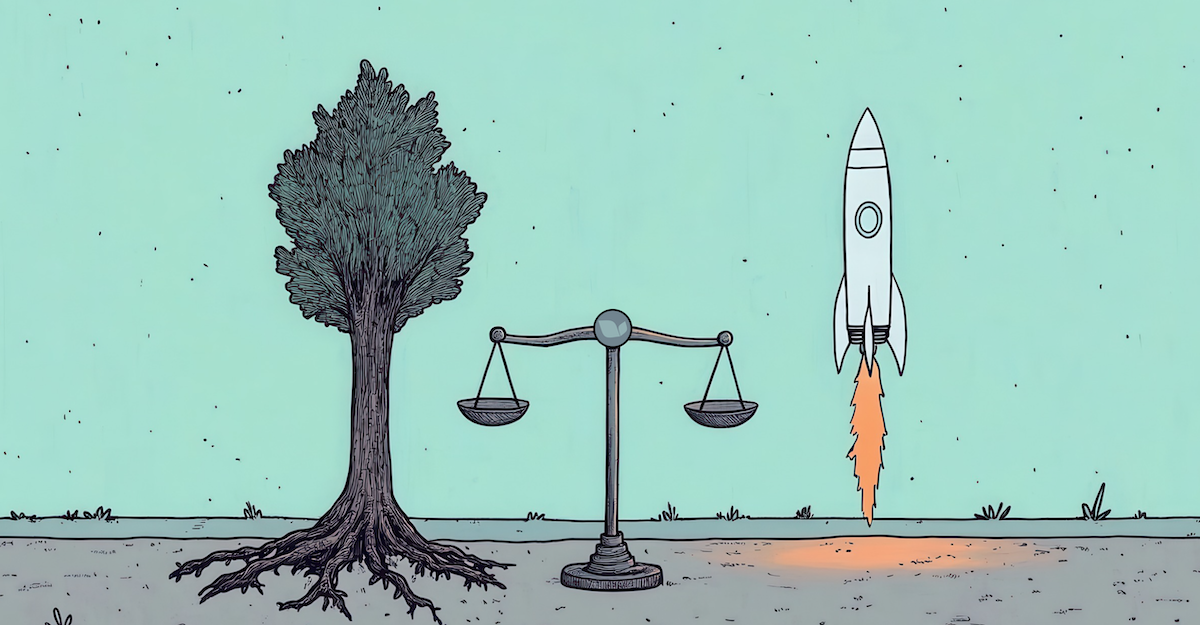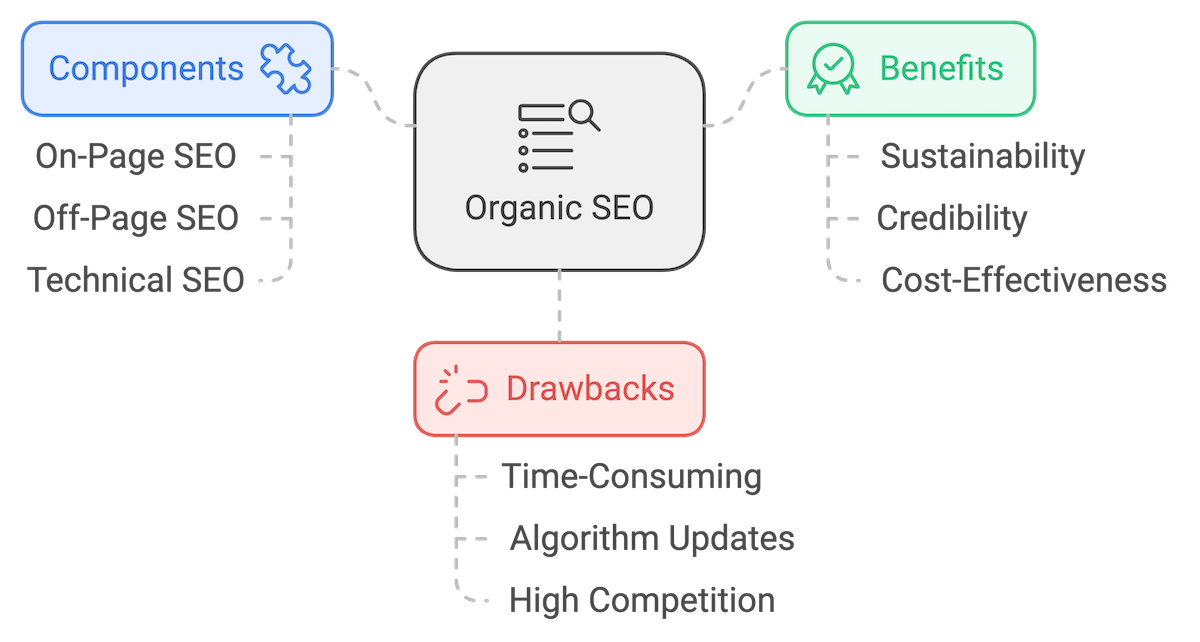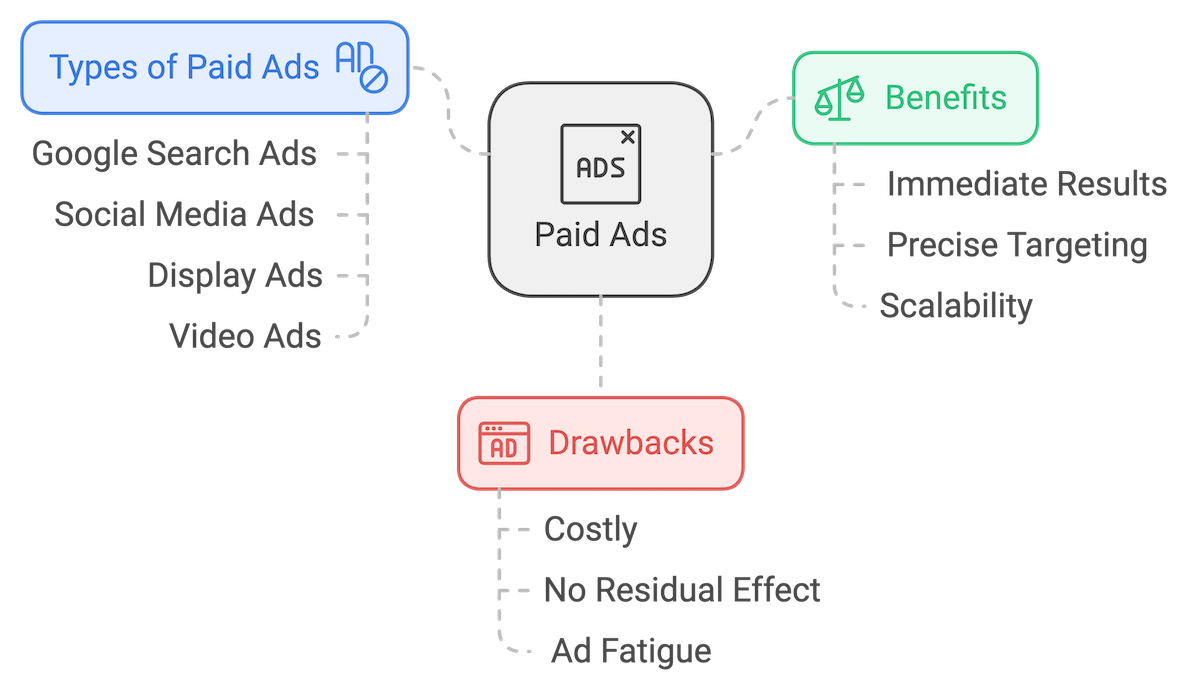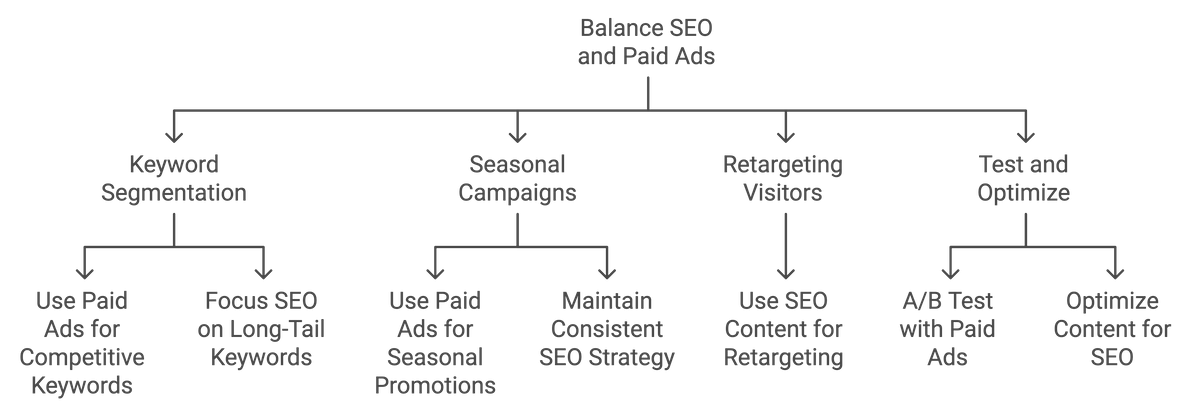How to Balance Organic SEO with Paid Ads (FREE Strategy Quiz Inside!)
By: Hayden Jarman

When deciding how to maximize the impact of your marketing strategy, businesses often ask: should I focus on organic SEO or paid ads?
The truth is, you need both. The real question is, how can you use them together to achieve the best results? By combining the long-term growth of SEO with the immediate visibility of paid ads, you can dominate search results and maximize your ROI.
Here’s how you can strike the perfect balance between organic SEO and paid ads to get the most out of your digital marketing efforts.
🎯 SEO vs. Paid Ads: Which Strategy Suits Your Business? 🔍
This quiz helps you determine whether organic SEO or paid ads are a better fit for your business goals. Let's get started!
Let's discover the best strategy for your business!
Table of Contents:
- Understanding Today’s Marketing Landscape
- What Organic SEO Brings to the Table
- The Instant Boost of Paid Ads
- How SEO and Paid Ads Work Together
- Practical Tips for Balancing SEO and Paid Ads
- Next Steps: How to Maximize Effectiveness with SEO and Paid Ads
- Additional Resources
Understanding Today’s Marketing Landscape
If you’re running any kind of business today, you’re already competing in an intense online marketplace.
Here are a few statistics that should catch your attention:
- In 2024, global ad spending is expected to hit $681.39 billion.
- Organic search drives 53% of website traffic, while paid search accounts for 15%.
- Businesses make an average of $2 in revenue for every $1 they spend on Google Ads.
The takeaway? Ignoring either strategy is a mistake.
SEO provides long-term sustainability, while paid ads offer immediate traffic and conversions. Together, they allow you to stay competitive in the ever-changing world of digital marketing. To learn more about the core differences and why both matter, check out this detailed comparison of SEO vs PPC for small businesses.
What Organic SEO Brings to the Table
What It Is and Why It Matters
Organic SEO involves optimizing your website so that search engines like Google rank your pages higher.
The ultimate goal? To attract more organic (unpaid) traffic. SEO is a multi-faceted strategy, including:
- On-Page SEO: Optimizing individual pages, including content, keywords, meta descriptions, and headings.
- Off-Page SEO: Building backlinks from credible websites to boost your domain’s authority.
- Technical SEO: Ensuring your website runs smoothly, is mobile-friendly, and can be easily crawled by search engines.
For a complete breakdown of how to get started, check out this guide on SEO.

The Benefits of Organic SEO
- Sustainability: Once you’ve built up a good organic ranking, traffic will continue flowing even if you’re not actively spending money on ads.
- Credibility: Users trust organic results more than paid ads, as they view them as unbiased.
- Cost-Effectiveness: While it takes time to build up your SEO, it’s much cheaper over the long run compared to continually paying for ads.
The Drawbacks
- Time-Consuming: You won’t see results overnight. It often takes 4-6 months for your SEO efforts to pay off.
- Algorithm Updates: Google regularly changes its algorithms, and you could lose rankings if you don’t adapt. Stay up-to-date by monitoring Google’s latest SEO updates for 2024.
- High Competition: For high-value keywords, you’ll often be competing against larger businesses with deeper pockets.
Key Stat: Organic search has an average 14.6% conversion rate, and the top 5 organic results account for 67.6% of all clicks.
Want to know if SEO is worth it for small businesses? Read this article.
The Instant Boost of Paid Ads
What Are Paid Ads?
Paid advertising, or pay-per-click (PPC), allows you to immediately reach your target audience by paying for visibility on search engines or social media platforms.
Unlike SEO, paid ads can deliver instant results.
Popular types of paid ads include:
- Google Search Ads: Appear at the top of Google’s search results for specific keywords.
- Social Media Ads: Run targeted ads on platforms like Facebook, Instagram, or LinkedIn.
- Display Ads: Banner ads that appear across a network of websites.
- Video Ads: Ads that run before or during video content on platforms like YouTube.
If you’re new to paid media, this guide on paid media advertising provides all the essentials you need to get started.

The Benefits of Paid Ads
- Immediate Results: You can start driving traffic as soon as your ad is live.
- Precise Targeting: Paid ads allow you to target users based on demographics, interests, and even behaviors.
- Scalability: You can quickly increase your reach by scaling up your ad spend.
The Drawbacks
- Costly: The more competitive your industry, the more expensive paid ads become.
- No Residual Effect: Once you stop paying, the traffic stops. There’s no long-term benefit like with SEO.
- Ad Fatigue: People can become blind to ads over time, reducing effectiveness.
Key Stat: Paid search has an average 10% conversion rate, and businesses typically see $2 return for every $1 they spend on Google Ads.
Looking to master the ins and outs of paid search? Here’s a complete guide to Google Ads.
How SEO and Paid Ads Work Together
The real magic happens when you combine SEO and paid ads.
Here’s how they work together to create a balanced and powerful marketing strategy:
Immediate vs. Long-Term
Paid ads are ideal for generating traffic quickly, whether you’re launching a new product or running a time-sensitive promotion.
Meanwhile, SEO builds a sustainable, long-term presence. By integrating both, you capture traffic at every stage of the customer journey.
Leveraging Paid Data to Improve SEO
Paid ads provide valuable data, such as which keywords and landing pages convert best. Use this information to optimize your SEO strategy.
By identifying high-converting keywords from your paid campaigns, you can focus on ranking for those terms organically. This technique is especially useful when dealing with competitive keywords, as explained in our guide to SEM.
Dominating SERPs
When your business appears in both the paid and organic sections of a search engine results page, you increase the chances of capturing clicks and building brand authority.
This approach not only boosts visibility but also enhances user trust by giving your brand a strong presence.
Key Stat: Paid ads increase website traffic by 53%, and 63% of paid ad clicks happen on Google.
For deeper insights on how paid search and SEO can complement each other, check out this article.
Practical Tips for Balancing SEO and Paid Ads
Now that you know how SEO and paid ads can work together, let’s dive into some actionable tips for balancing both strategies effectively.

1. Keyword Segmentation
For highly competitive keywords that are tough to rank for organically, use paid ads.
On the flip side, focus your SEO efforts on long-tail keywords, which are less competitive but can still drive valuable traffic over time.
For example, if you’re targeting high-intent keywords like “best SEO tools,” use a mix of both organic and paid approaches.
You can also explore our blog on the best SEO tools for small businesses to see which ones fit your needs.
2. Seasonal Campaigns
Use paid ads to support seasonal promotions, product launches, or time-sensitive offers, while letting your SEO strategy build a consistent foundation throughout the year.
3. Retargeting Visitors
Leverage your SEO-driven content to retarget visitors from paid ads.
For example, someone might click on an ad, visit your site, and leave without converting. By using retargeting strategies through SEO-driven blog posts, you can bring them back and encourage a purchase.
4. Test and Optimize
Use paid ads to A/B test headlines, landing pages, and keywords before committing to long-term SEO strategies. Once you know what works, invest in optimizing your content for organic search.
For a deeper understanding of how to choose between paid search and paid social ads, visit this blog.
Chart: Testing PPC Campaigns for SEO Optimization
| Metric | PPC Test | SEO Application |
|---|---|---|
| Conversion Rate | Measure ad effectiveness | Build landing pages based on results |
| Click-Through Rate (CTR) | Test headline variations | Optimize blog and page headlines |
| Bounce Rate | Gauge visitor interest | Improve site navigation and content |
Next Steps: How to Maximize Effectiveness with SEO and Paid Ads
Balancing SEO and paid ads is all about using their unique strengths to create a marketing strategy that delivers immediate traffic while building long-term growth.
Paid ads offer quick wins and data insights, while SEO ensures sustainability and credibility.
To recap:
- Use paid ads for immediate visibility and time-sensitive promotions.
- Invest in SEO for long-term growth and higher credibility.
- Leverage PPC data to refine your SEO strategy.
- Retarget visitors with SEO content to re-engage your audience.
If you’re not already combining these strategies, now is the time to do so. To learn more about balancing both SEO and paid ads effectively, read this in-depth article.
Recommended Tools:
- Google Analytics
- SEMrush
- Ahrefs
- Google Ads
- Google Search Console
Remember, the most effective marketing strategies aren’t about choosing one or the other—it’s about balancing both SEO and paid ads for maximum ROI.
Use the tips shared here, stay informed with the latest updates, and continue optimizing your approach for the best results.
Additional Resources
To dive deeper into the subject of balancing organic SEO with paid ads, here are some valuable resources:
- Global Digital Ad Spending Statistics (Statista)
- BrightEdge Channel Report on Organic Search
- Think with Google: Search Marketing Strategies
- WordStream's Google Ads Industry Benchmarks
- SEO vs. PPC: Search Engine Journal
- Google Ads Resources
- SEMrush Blog: SEO vs. PPC
- Ahrefs Guide: SEO vs. PPC
- Search Engine Watch: SEO Trends for 2024
- DigitalMarketer Blog: How SEO and PPC Work Together
Need help balancing your SEO and paid ads strategies?
Reach out to BlueTone Media to optimize your digital marketing efforts and achieve the perfect balance for maximum effectiveness.
Our team of experts is ready to assist you in driving both immediate and long-term results for your business!
Related Posts:
- Understanding Google’s Local Pack: How to Get Featured
- Google Business Profile FAQs: Everything You Need to Know
- The Best Google Ads Extensions to Boost Your Click-Through Rates
- How to Leverage Facebook Groups for Local Business Leads
- How to Use AI to Write Better Social Media Captions
- How to Optimize Google Reviews to Attract More Customers
- LinkedIn for B2B Marketing Success
- How to Conduct a Social Media Audit (w/ "Audit Readiness" Quiz!)
- Creating a Content Calendar for Consistent Posting
- The Importance of Mobile Optimization in 2024
- Data Privacy Regulations: What Marketers Need to Know
- The Role of Chatbots in Enhancing Customer Service
- SEO for Small Business: The Ultimate Guide to Getting Found Online
- The Role of Keyword Clustering in Modern SEO

